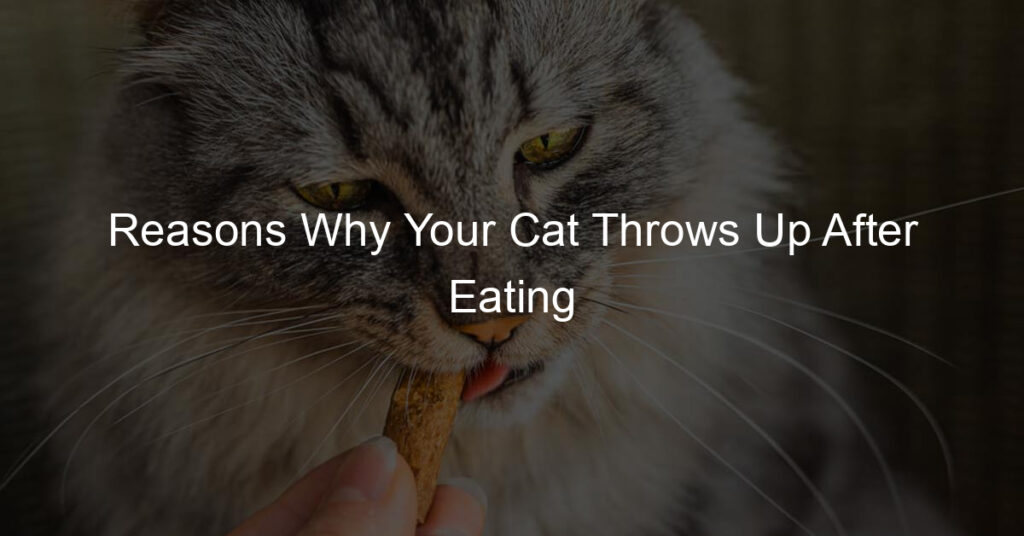If you have a cat, chances are you’ve experienced the dreaded “cat barf” at least once. Although it’s not pleasant, vomiting is a normal part of your cat’s digestive process. So why does it happen? Let’s take a look at some of the most common reasons why cats throw up after eating.
Why does my cat vomit immediately after eating?
Vomiting immediately after eating can be a frustrating problem for cat owners, but there are many potential causes. Poor digestion is the most common cause, often because the cat is eating too quickly or not chewing the food properly. Health issues such as inflammatory bowel disease and liver disease can also lead to vomiting shortly after meals.
Hairballs from self-grooming can sometimes come out via vomiting several hours away from mealtime, so it’s important to observe closely to distinguish between hairballs and other causes. Talk to your vet if this behavior persists as they may suggest medical solutions, dietary changes, or even feeding more small meals throughout the day rather than one larger meal.
When should I be concerned about my cat throwing up?
If your cat is throwing up more than once a week, it could be cause for concern. While cats occasionally vomit after eating something they don’t agree with, frequent vomiting can be a sign of an underlying problem such as intestinal issues, pancreatitis, kidney disease, parasites, or even cancer.
If your cat is vomiting frequently, always consult with your vet to figure out the underlying cause and get the proper treatment. Look out for other signs such as weight loss or lethargy which can point to a health issue. Checking in with your vet ahead of time can save you hassle down the line and even prevent more serious illnesses from developing.
What is the most common cause of vomiting in cats?
Believe it or not, hairballs are the number one culprit when it comes to cats vomiting. These collections of swallowed fur can accumulate in a cat’s stomach and cause them to throw up as a way of getting rid of the debris. Even though they’re most commonly linked with our feline friends, hairballs can occur in all types of pets!
To make matters worse, cats have no problem-consuming large amounts of fur during their everyday grooming session – growing longer hairs further increases their chances of throwing up hairballs. Thankfully, there are ways to lower the risk by taking preventative measures such as brushing your kitty often and providing them with proper nutrition.
How can I treat my cat for vomiting at home?
If your cat is vomiting up their food or treats, it’s important to make sure they stay hydrated and get the treatment they need. One of the best ways to treat your cat for vomiting at home is to provide them with a bland diet that is low in fat and easy to digest. You can also give them small amounts of water in-between meals to help prevent dehydration.
If the vomiting persists, it’s important to seek professional medical advice from a vet as soon as possible to determine the underlying cause before it becomes more serious. Keeping them comfortable and providing plenty of rest will also help speed up their recovery.
What are the symptoms of an upset stomach in cats?
You may be wondering if your cat’s upset stomach has progressed, especially when he or she exhibits some troubling signs. Common symptoms of an unsettled stomach in cats include vomiting and loss of appetite. But other signs to pay close attention to include lack of energy, tense abdominal muscles, and irritable behavior.
Loose stools are also quite common when cats have stomach issues, along with excessive licking of the lips and attempting to eat unusual items such as fabric or grass. While these behaviors don’t always mean your pet has gastrointestinal issues, it’s worth considering a vet visit to make sure everything is OK with your furry friend.
In Conclusion
If you suspect that your cat is throwing up due to a food allergy or dietary issue, a vet visit is needed to identify any underlying medical issues. Otherwise, there might be a more pressing reason why your beloved pet is not feeling well. Try adjusting the frequency and amount of meals and keep an eye on food quality.
Additionally, look out for unhealthy habits like overeating or playing with their food which can also contribute to cats getting sick after eating. Remember, if you have any further questions or concerns always make sure to check with your vet first as they will be able to tell you everything you need to know!
Taking these steps will help keep your sense of security when feeding your furry friend and provide them with the best care possible.








